Effects of Sleep Deprivation on Academic Performance in Adolescents
VerifiedAdded on 2023/04/22
|19
|3978
|323
AI Summary
This study examines the relationship between sleep deprivation and academic performance in adolescents. It explores the impact of sleep quality and duration on cognitive processes and memory formation. The study uses a quantitative approach to collect data from high school students and evaluates sleepiness levels and academic performance. The findings aim to determine if improvements in sleep quality and time can enhance academic performance in adolescents.
Contribute Materials
Your contribution can guide someone’s learning journey. Share your
documents today.
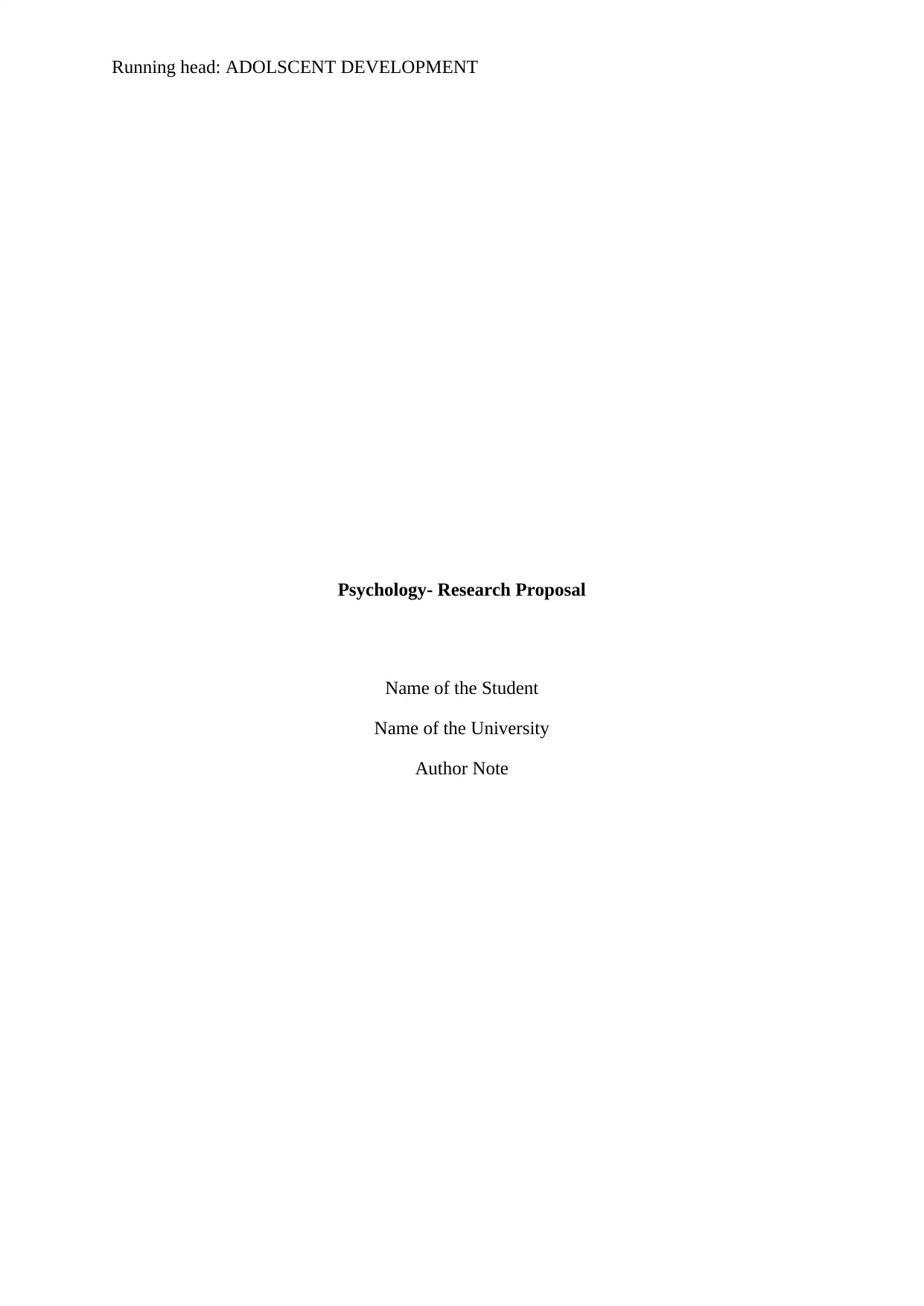
Running head: ADOLSCENT DEVELOPMENT
Psychology- Research Proposal
Name of the Student
Name of the University
Author Note
Psychology- Research Proposal
Name of the Student
Name of the University
Author Note
Secure Best Marks with AI Grader
Need help grading? Try our AI Grader for instant feedback on your assignments.
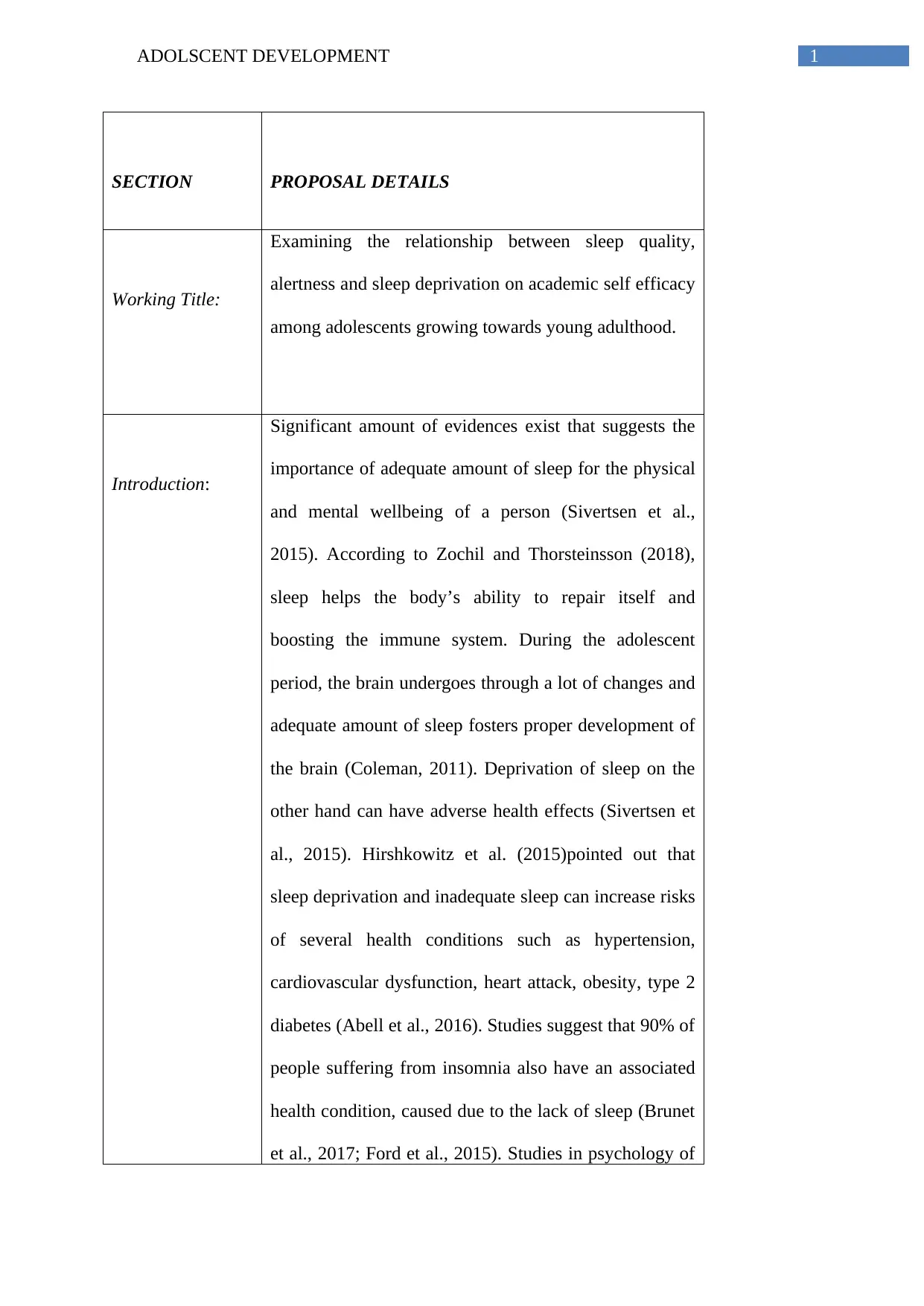
1ADOLSCENT DEVELOPMENT
SECTION PROPOSAL DETAILS
Working Title:
Examining the relationship between sleep quality,
alertness and sleep deprivation on academic self efficacy
among adolescents growing towards young adulthood.
Introduction:
Significant amount of evidences exist that suggests the
importance of adequate amount of sleep for the physical
and mental wellbeing of a person (Sivertsen et al.,
2015). According to Zochil and Thorsteinsson (2018),
sleep helps the body’s ability to repair itself and
boosting the immune system. During the adolescent
period, the brain undergoes through a lot of changes and
adequate amount of sleep fosters proper development of
the brain (Coleman, 2011). Deprivation of sleep on the
other hand can have adverse health effects (Sivertsen et
al., 2015). Hirshkowitz et al. (2015)pointed out that
sleep deprivation and inadequate sleep can increase risks
of several health conditions such as hypertension,
cardiovascular dysfunction, heart attack, obesity, type 2
diabetes (Abell et al., 2016). Studies suggest that 90% of
people suffering from insomnia also have an associated
health condition, caused due to the lack of sleep (Brunet
et al., 2017; Ford et al., 2015). Studies in psychology of
SECTION PROPOSAL DETAILS
Working Title:
Examining the relationship between sleep quality,
alertness and sleep deprivation on academic self efficacy
among adolescents growing towards young adulthood.
Introduction:
Significant amount of evidences exist that suggests the
importance of adequate amount of sleep for the physical
and mental wellbeing of a person (Sivertsen et al.,
2015). According to Zochil and Thorsteinsson (2018),
sleep helps the body’s ability to repair itself and
boosting the immune system. During the adolescent
period, the brain undergoes through a lot of changes and
adequate amount of sleep fosters proper development of
the brain (Coleman, 2011). Deprivation of sleep on the
other hand can have adverse health effects (Sivertsen et
al., 2015). Hirshkowitz et al. (2015)pointed out that
sleep deprivation and inadequate sleep can increase risks
of several health conditions such as hypertension,
cardiovascular dysfunction, heart attack, obesity, type 2
diabetes (Abell et al., 2016). Studies suggest that 90% of
people suffering from insomnia also have an associated
health condition, caused due to the lack of sleep (Brunet
et al., 2017; Ford et al., 2015). Studies in psychology of
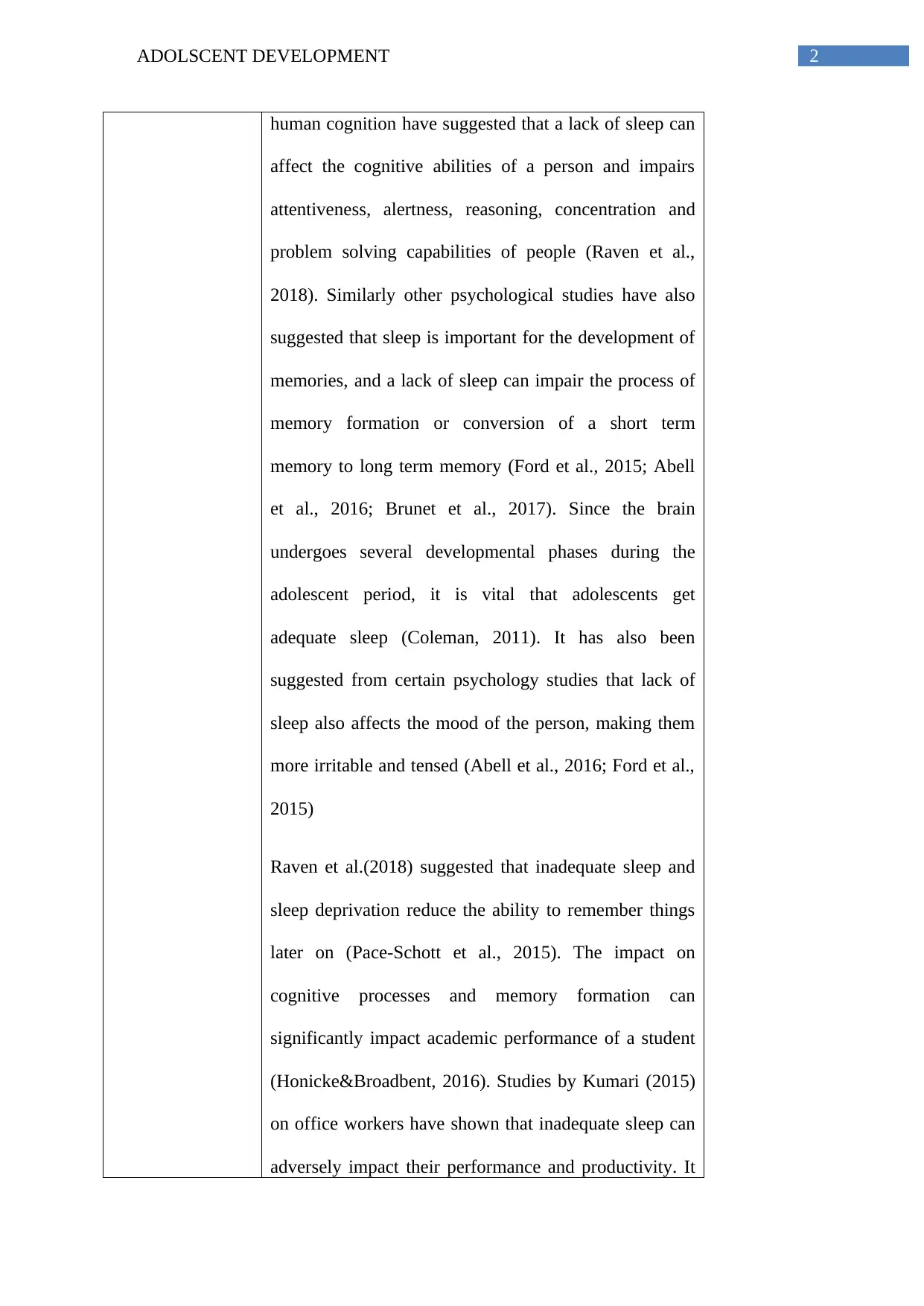
2ADOLSCENT DEVELOPMENT
human cognition have suggested that a lack of sleep can
affect the cognitive abilities of a person and impairs
attentiveness, alertness, reasoning, concentration and
problem solving capabilities of people (Raven et al.,
2018). Similarly other psychological studies have also
suggested that sleep is important for the development of
memories, and a lack of sleep can impair the process of
memory formation or conversion of a short term
memory to long term memory (Ford et al., 2015; Abell
et al., 2016; Brunet et al., 2017). Since the brain
undergoes several developmental phases during the
adolescent period, it is vital that adolescents get
adequate sleep (Coleman, 2011). It has also been
suggested from certain psychology studies that lack of
sleep also affects the mood of the person, making them
more irritable and tensed (Abell et al., 2016; Ford et al.,
2015)
Raven et al.(2018) suggested that inadequate sleep and
sleep deprivation reduce the ability to remember things
later on (Pace-Schott et al., 2015). The impact on
cognitive processes and memory formation can
significantly impact academic performance of a student
(Honicke&Broadbent, 2016). Studies by Kumari (2015)
on office workers have shown that inadequate sleep can
adversely impact their performance and productivity. It
human cognition have suggested that a lack of sleep can
affect the cognitive abilities of a person and impairs
attentiveness, alertness, reasoning, concentration and
problem solving capabilities of people (Raven et al.,
2018). Similarly other psychological studies have also
suggested that sleep is important for the development of
memories, and a lack of sleep can impair the process of
memory formation or conversion of a short term
memory to long term memory (Ford et al., 2015; Abell
et al., 2016; Brunet et al., 2017). Since the brain
undergoes several developmental phases during the
adolescent period, it is vital that adolescents get
adequate sleep (Coleman, 2011). It has also been
suggested from certain psychology studies that lack of
sleep also affects the mood of the person, making them
more irritable and tensed (Abell et al., 2016; Ford et al.,
2015)
Raven et al.(2018) suggested that inadequate sleep and
sleep deprivation reduce the ability to remember things
later on (Pace-Schott et al., 2015). The impact on
cognitive processes and memory formation can
significantly impact academic performance of a student
(Honicke&Broadbent, 2016). Studies by Kumari (2015)
on office workers have shown that inadequate sleep can
adversely impact their performance and productivity. It
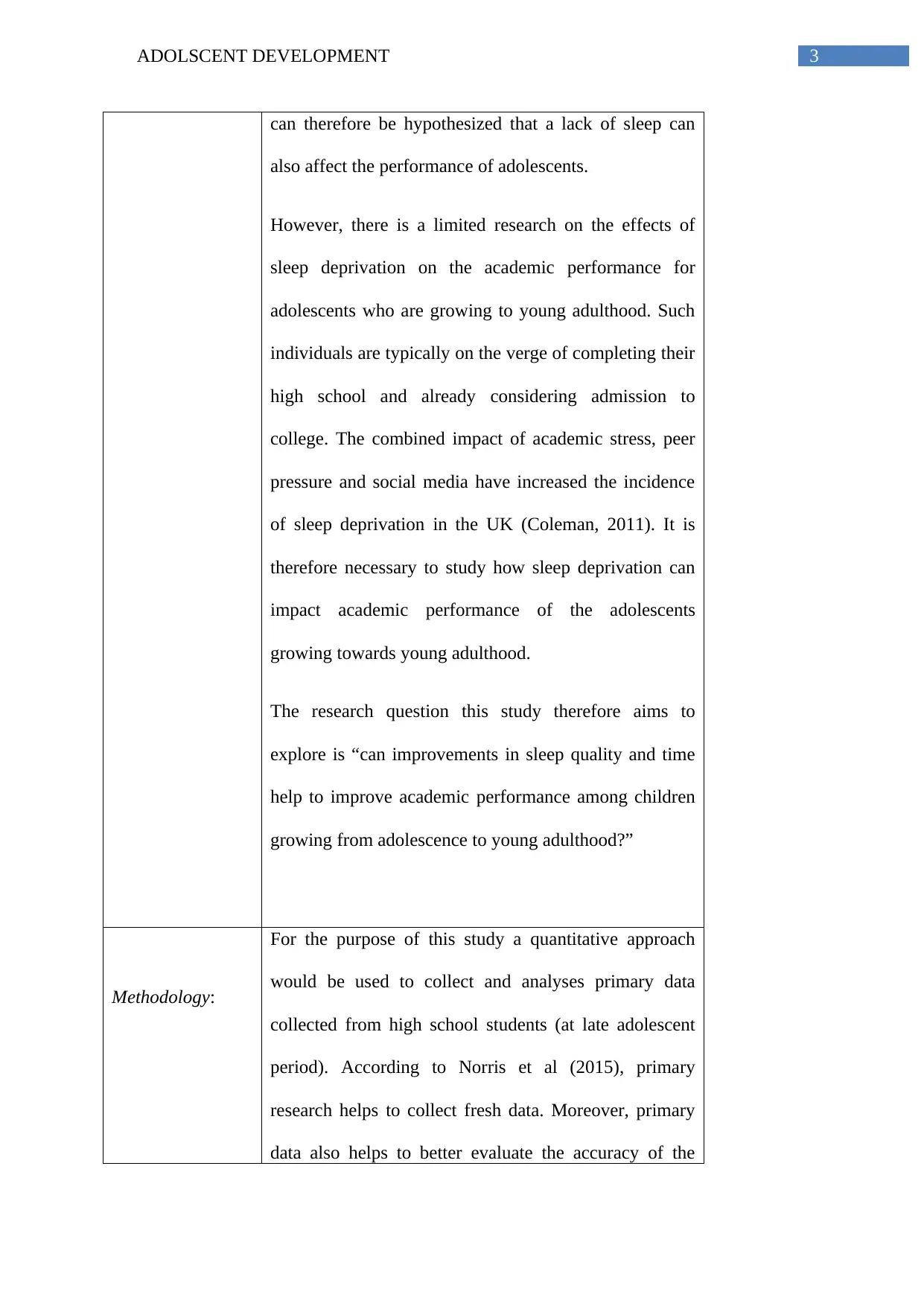
3ADOLSCENT DEVELOPMENT
can therefore be hypothesized that a lack of sleep can
also affect the performance of adolescents.
However, there is a limited research on the effects of
sleep deprivation on the academic performance for
adolescents who are growing to young adulthood. Such
individuals are typically on the verge of completing their
high school and already considering admission to
college. The combined impact of academic stress, peer
pressure and social media have increased the incidence
of sleep deprivation in the UK (Coleman, 2011). It is
therefore necessary to study how sleep deprivation can
impact academic performance of the adolescents
growing towards young adulthood.
The research question this study therefore aims to
explore is “can improvements in sleep quality and time
help to improve academic performance among children
growing from adolescence to young adulthood?”
Methodology:
For the purpose of this study a quantitative approach
would be used to collect and analyses primary data
collected from high school students (at late adolescent
period). According to Norris et al (2015), primary
research helps to collect fresh data. Moreover, primary
data also helps to better evaluate the accuracy of the
can therefore be hypothesized that a lack of sleep can
also affect the performance of adolescents.
However, there is a limited research on the effects of
sleep deprivation on the academic performance for
adolescents who are growing to young adulthood. Such
individuals are typically on the verge of completing their
high school and already considering admission to
college. The combined impact of academic stress, peer
pressure and social media have increased the incidence
of sleep deprivation in the UK (Coleman, 2011). It is
therefore necessary to study how sleep deprivation can
impact academic performance of the adolescents
growing towards young adulthood.
The research question this study therefore aims to
explore is “can improvements in sleep quality and time
help to improve academic performance among children
growing from adolescence to young adulthood?”
Methodology:
For the purpose of this study a quantitative approach
would be used to collect and analyses primary data
collected from high school students (at late adolescent
period). According to Norris et al (2015), primary
research helps to collect fresh data. Moreover, primary
data also helps to better evaluate the accuracy of the
Secure Best Marks with AI Grader
Need help grading? Try our AI Grader for instant feedback on your assignments.
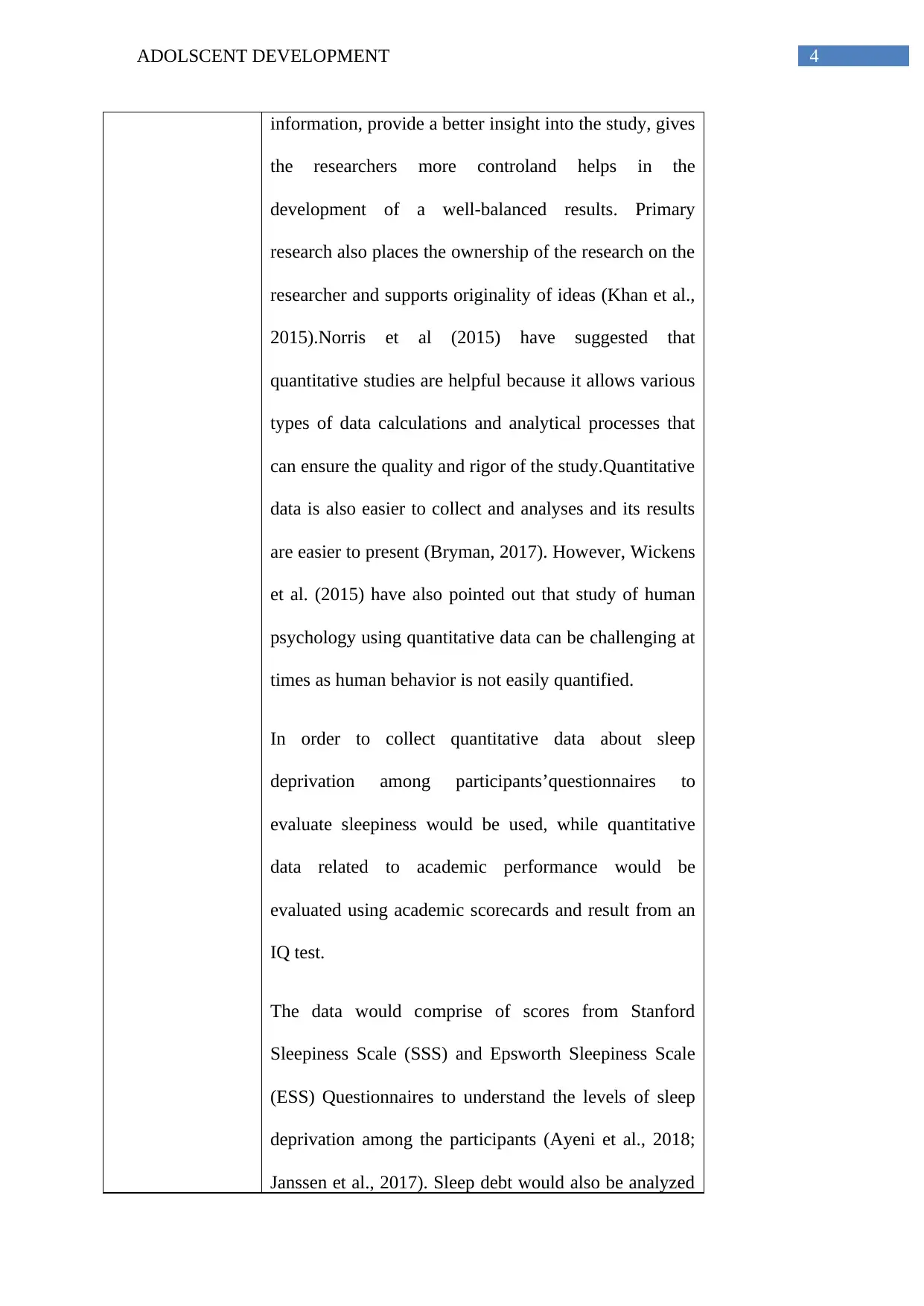
4ADOLSCENT DEVELOPMENT
information, provide a better insight into the study, gives
the researchers more controland helps in the
development of a well-balanced results. Primary
research also places the ownership of the research on the
researcher and supports originality of ideas (Khan et al.,
2015).Norris et al (2015) have suggested that
quantitative studies are helpful because it allows various
types of data calculations and analytical processes that
can ensure the quality and rigor of the study.Quantitative
data is also easier to collect and analyses and its results
are easier to present (Bryman, 2017). However, Wickens
et al. (2015) have also pointed out that study of human
psychology using quantitative data can be challenging at
times as human behavior is not easily quantified.
In order to collect quantitative data about sleep
deprivation among participants’questionnaires to
evaluate sleepiness would be used, while quantitative
data related to academic performance would be
evaluated using academic scorecards and result from an
IQ test.
The data would comprise of scores from Stanford
Sleepiness Scale (SSS) and Epsworth Sleepiness Scale
(ESS) Questionnaires to understand the levels of sleep
deprivation among the participants (Ayeni et al., 2018;
Janssen et al., 2017). Sleep debt would also be analyzed
information, provide a better insight into the study, gives
the researchers more controland helps in the
development of a well-balanced results. Primary
research also places the ownership of the research on the
researcher and supports originality of ideas (Khan et al.,
2015).Norris et al (2015) have suggested that
quantitative studies are helpful because it allows various
types of data calculations and analytical processes that
can ensure the quality and rigor of the study.Quantitative
data is also easier to collect and analyses and its results
are easier to present (Bryman, 2017). However, Wickens
et al. (2015) have also pointed out that study of human
psychology using quantitative data can be challenging at
times as human behavior is not easily quantified.
In order to collect quantitative data about sleep
deprivation among participants’questionnaires to
evaluate sleepiness would be used, while quantitative
data related to academic performance would be
evaluated using academic scorecards and result from an
IQ test.
The data would comprise of scores from Stanford
Sleepiness Scale (SSS) and Epsworth Sleepiness Scale
(ESS) Questionnaires to understand the levels of sleep
deprivation among the participants (Ayeni et al., 2018;
Janssen et al., 2017). Sleep debt would also be analyzed
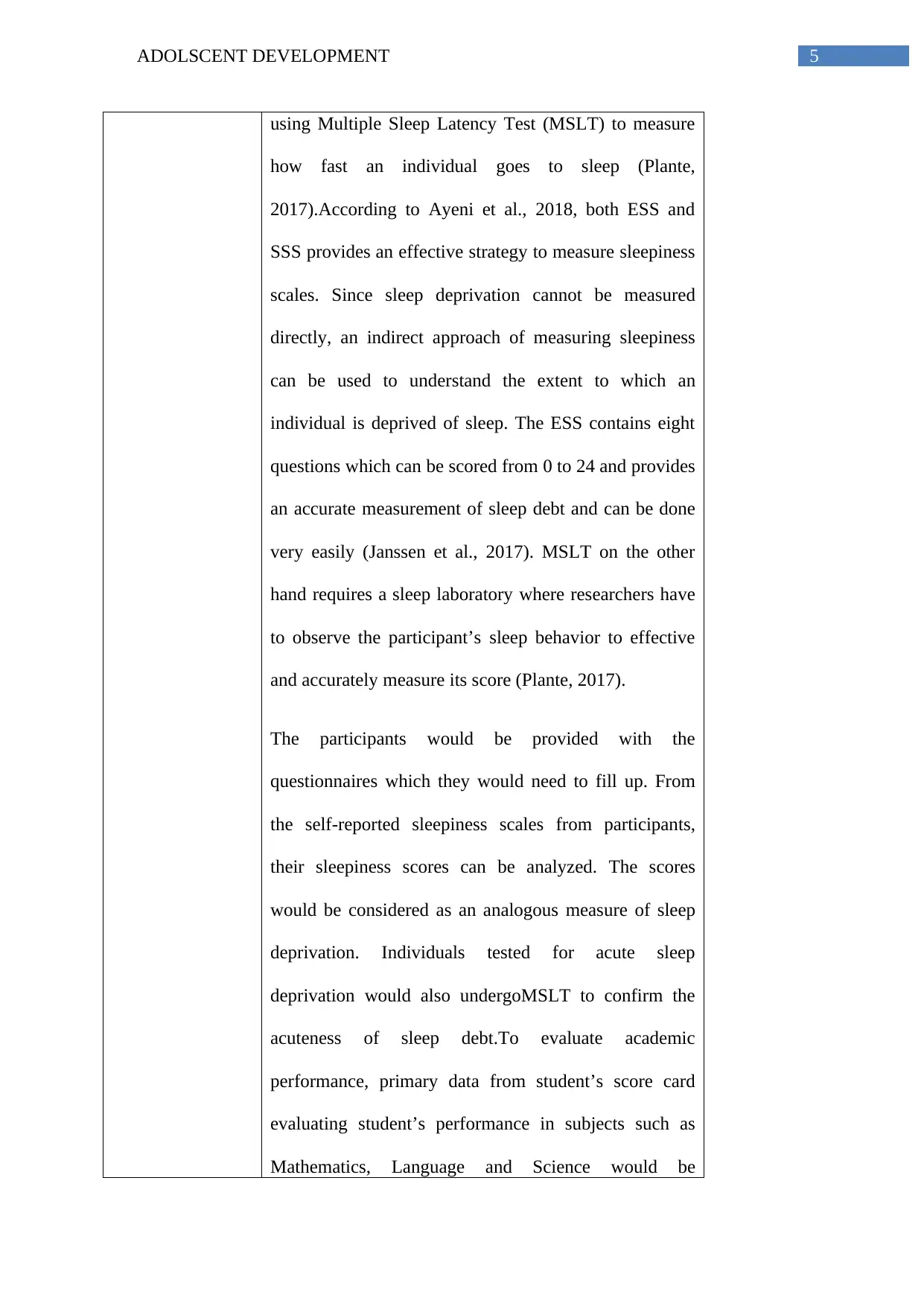
5ADOLSCENT DEVELOPMENT
using Multiple Sleep Latency Test (MSLT) to measure
how fast an individual goes to sleep (Plante,
2017).According to Ayeni et al., 2018, both ESS and
SSS provides an effective strategy to measure sleepiness
scales. Since sleep deprivation cannot be measured
directly, an indirect approach of measuring sleepiness
can be used to understand the extent to which an
individual is deprived of sleep. The ESS contains eight
questions which can be scored from 0 to 24 and provides
an accurate measurement of sleep debt and can be done
very easily (Janssen et al., 2017). MSLT on the other
hand requires a sleep laboratory where researchers have
to observe the participant’s sleep behavior to effective
and accurately measure its score (Plante, 2017).
The participants would be provided with the
questionnaires which they would need to fill up. From
the self-reported sleepiness scales from participants,
their sleepiness scores can be analyzed. The scores
would be considered as an analogous measure of sleep
deprivation. Individuals tested for acute sleep
deprivation would also undergoMSLT to confirm the
acuteness of sleep debt.To evaluate academic
performance, primary data from student’s score card
evaluating student’s performance in subjects such as
Mathematics, Language and Science would be
using Multiple Sleep Latency Test (MSLT) to measure
how fast an individual goes to sleep (Plante,
2017).According to Ayeni et al., 2018, both ESS and
SSS provides an effective strategy to measure sleepiness
scales. Since sleep deprivation cannot be measured
directly, an indirect approach of measuring sleepiness
can be used to understand the extent to which an
individual is deprived of sleep. The ESS contains eight
questions which can be scored from 0 to 24 and provides
an accurate measurement of sleep debt and can be done
very easily (Janssen et al., 2017). MSLT on the other
hand requires a sleep laboratory where researchers have
to observe the participant’s sleep behavior to effective
and accurately measure its score (Plante, 2017).
The participants would be provided with the
questionnaires which they would need to fill up. From
the self-reported sleepiness scales from participants,
their sleepiness scores can be analyzed. The scores
would be considered as an analogous measure of sleep
deprivation. Individuals tested for acute sleep
deprivation would also undergoMSLT to confirm the
acuteness of sleep debt.To evaluate academic
performance, primary data from student’s score card
evaluating student’s performance in subjects such as
Mathematics, Language and Science would be
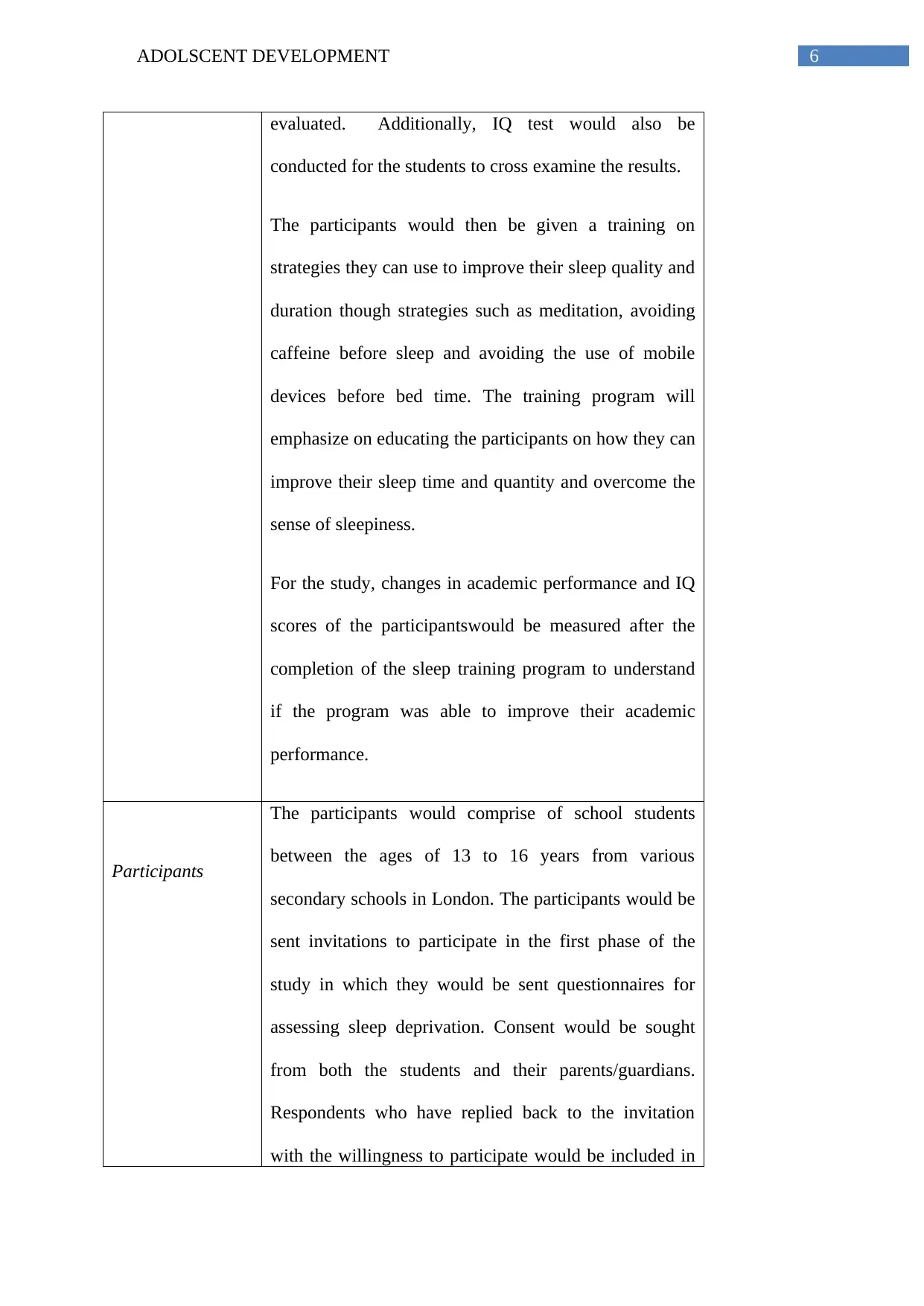
6ADOLSCENT DEVELOPMENT
evaluated. Additionally, IQ test would also be
conducted for the students to cross examine the results.
The participants would then be given a training on
strategies they can use to improve their sleep quality and
duration though strategies such as meditation, avoiding
caffeine before sleep and avoiding the use of mobile
devices before bed time. The training program will
emphasize on educating the participants on how they can
improve their sleep time and quantity and overcome the
sense of sleepiness.
For the study, changes in academic performance and IQ
scores of the participantswould be measured after the
completion of the sleep training program to understand
if the program was able to improve their academic
performance.
Participants
The participants would comprise of school students
between the ages of 13 to 16 years from various
secondary schools in London. The participants would be
sent invitations to participate in the first phase of the
study in which they would be sent questionnaires for
assessing sleep deprivation. Consent would be sought
from both the students and their parents/guardians.
Respondents who have replied back to the invitation
with the willingness to participate would be included in
evaluated. Additionally, IQ test would also be
conducted for the students to cross examine the results.
The participants would then be given a training on
strategies they can use to improve their sleep quality and
duration though strategies such as meditation, avoiding
caffeine before sleep and avoiding the use of mobile
devices before bed time. The training program will
emphasize on educating the participants on how they can
improve their sleep time and quantity and overcome the
sense of sleepiness.
For the study, changes in academic performance and IQ
scores of the participantswould be measured after the
completion of the sleep training program to understand
if the program was able to improve their academic
performance.
Participants
The participants would comprise of school students
between the ages of 13 to 16 years from various
secondary schools in London. The participants would be
sent invitations to participate in the first phase of the
study in which they would be sent questionnaires for
assessing sleep deprivation. Consent would be sought
from both the students and their parents/guardians.
Respondents who have replied back to the invitation
with the willingness to participate would be included in
Paraphrase This Document
Need a fresh take? Get an instant paraphrase of this document with our AI Paraphraser
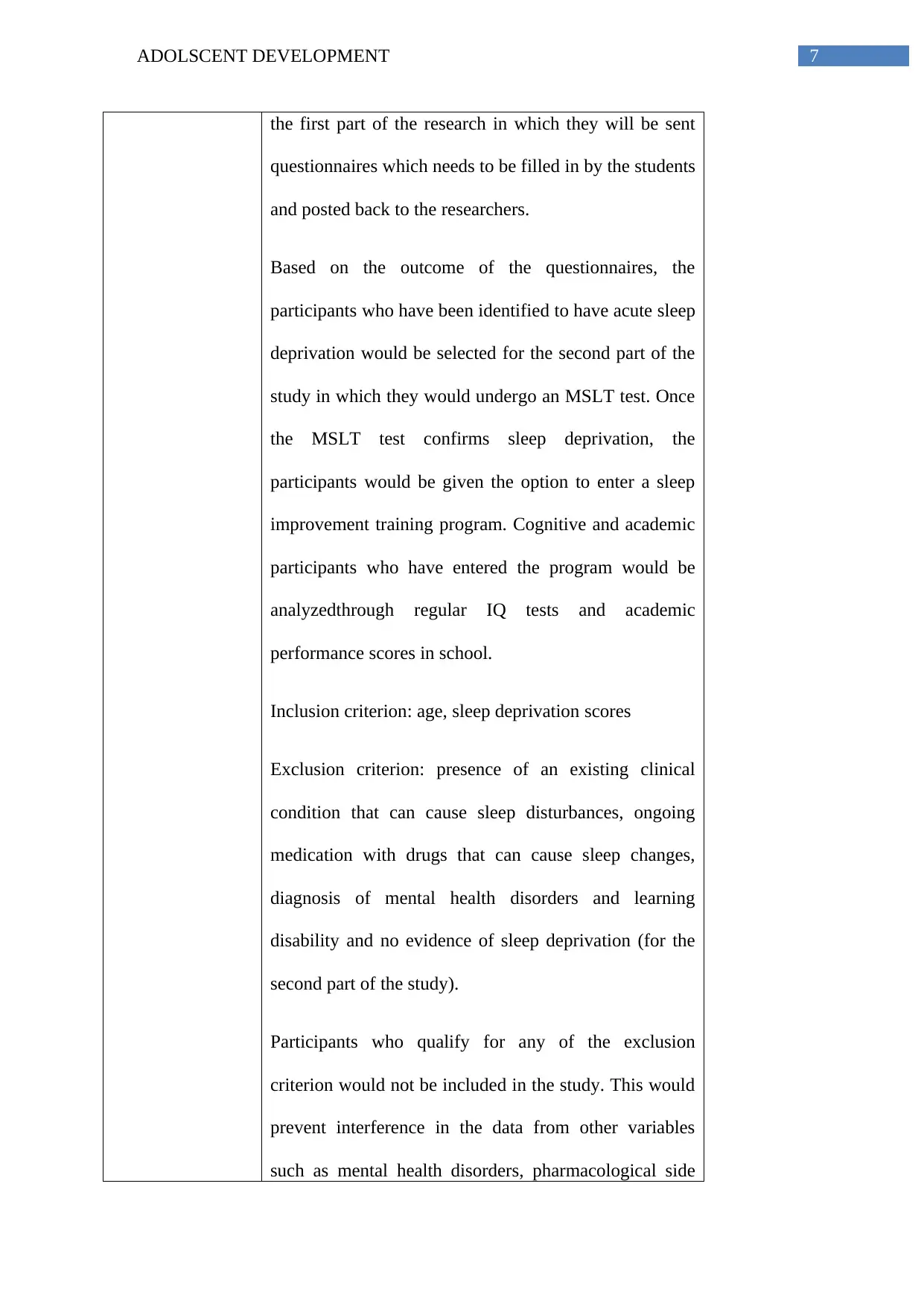
7ADOLSCENT DEVELOPMENT
the first part of the research in which they will be sent
questionnaires which needs to be filled in by the students
and posted back to the researchers.
Based on the outcome of the questionnaires, the
participants who have been identified to have acute sleep
deprivation would be selected for the second part of the
study in which they would undergo an MSLT test. Once
the MSLT test confirms sleep deprivation, the
participants would be given the option to enter a sleep
improvement training program. Cognitive and academic
participants who have entered the program would be
analyzedthrough regular IQ tests and academic
performance scores in school.
Inclusion criterion: age, sleep deprivation scores
Exclusion criterion: presence of an existing clinical
condition that can cause sleep disturbances, ongoing
medication with drugs that can cause sleep changes,
diagnosis of mental health disorders and learning
disability and no evidence of sleep deprivation (for the
second part of the study).
Participants who qualify for any of the exclusion
criterion would not be included in the study. This would
prevent interference in the data from other variables
such as mental health disorders, pharmacological side
the first part of the research in which they will be sent
questionnaires which needs to be filled in by the students
and posted back to the researchers.
Based on the outcome of the questionnaires, the
participants who have been identified to have acute sleep
deprivation would be selected for the second part of the
study in which they would undergo an MSLT test. Once
the MSLT test confirms sleep deprivation, the
participants would be given the option to enter a sleep
improvement training program. Cognitive and academic
participants who have entered the program would be
analyzedthrough regular IQ tests and academic
performance scores in school.
Inclusion criterion: age, sleep deprivation scores
Exclusion criterion: presence of an existing clinical
condition that can cause sleep disturbances, ongoing
medication with drugs that can cause sleep changes,
diagnosis of mental health disorders and learning
disability and no evidence of sleep deprivation (for the
second part of the study).
Participants who qualify for any of the exclusion
criterion would not be included in the study. This would
prevent interference in the data from other variables
such as mental health disorders, pharmacological side
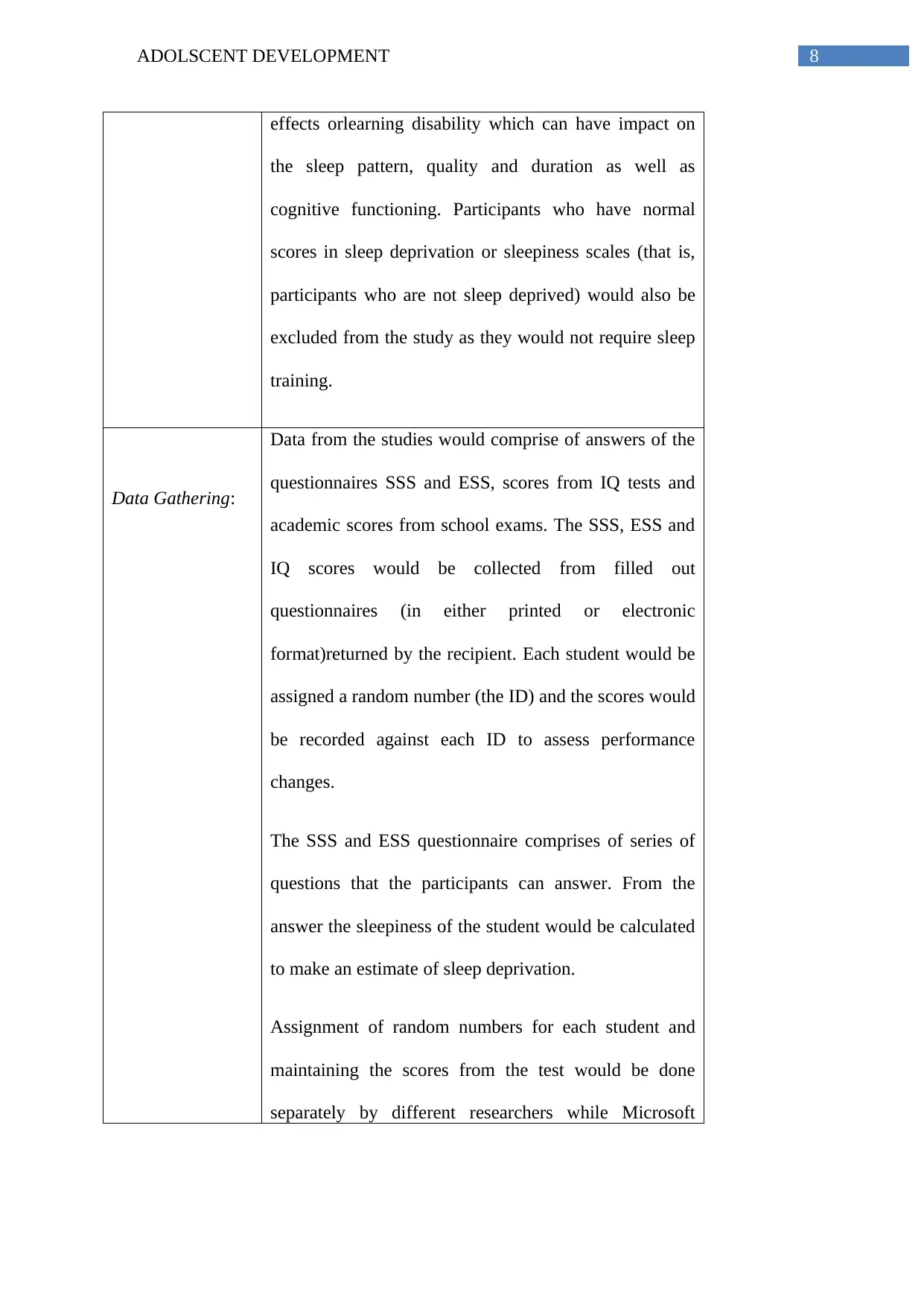
8ADOLSCENT DEVELOPMENT
effects orlearning disability which can have impact on
the sleep pattern, quality and duration as well as
cognitive functioning. Participants who have normal
scores in sleep deprivation or sleepiness scales (that is,
participants who are not sleep deprived) would also be
excluded from the study as they would not require sleep
training.
Data Gathering:
Data from the studies would comprise of answers of the
questionnaires SSS and ESS, scores from IQ tests and
academic scores from school exams. The SSS, ESS and
IQ scores would be collected from filled out
questionnaires (in either printed or electronic
format)returned by the recipient. Each student would be
assigned a random number (the ID) and the scores would
be recorded against each ID to assess performance
changes.
The SSS and ESS questionnaire comprises of series of
questions that the participants can answer. From the
answer the sleepiness of the student would be calculated
to make an estimate of sleep deprivation.
Assignment of random numbers for each student and
maintaining the scores from the test would be done
separately by different researchers while Microsoft
effects orlearning disability which can have impact on
the sleep pattern, quality and duration as well as
cognitive functioning. Participants who have normal
scores in sleep deprivation or sleepiness scales (that is,
participants who are not sleep deprived) would also be
excluded from the study as they would not require sleep
training.
Data Gathering:
Data from the studies would comprise of answers of the
questionnaires SSS and ESS, scores from IQ tests and
academic scores from school exams. The SSS, ESS and
IQ scores would be collected from filled out
questionnaires (in either printed or electronic
format)returned by the recipient. Each student would be
assigned a random number (the ID) and the scores would
be recorded against each ID to assess performance
changes.
The SSS and ESS questionnaire comprises of series of
questions that the participants can answer. From the
answer the sleepiness of the student would be calculated
to make an estimate of sleep deprivation.
Assignment of random numbers for each student and
maintaining the scores from the test would be done
separately by different researchers while Microsoft
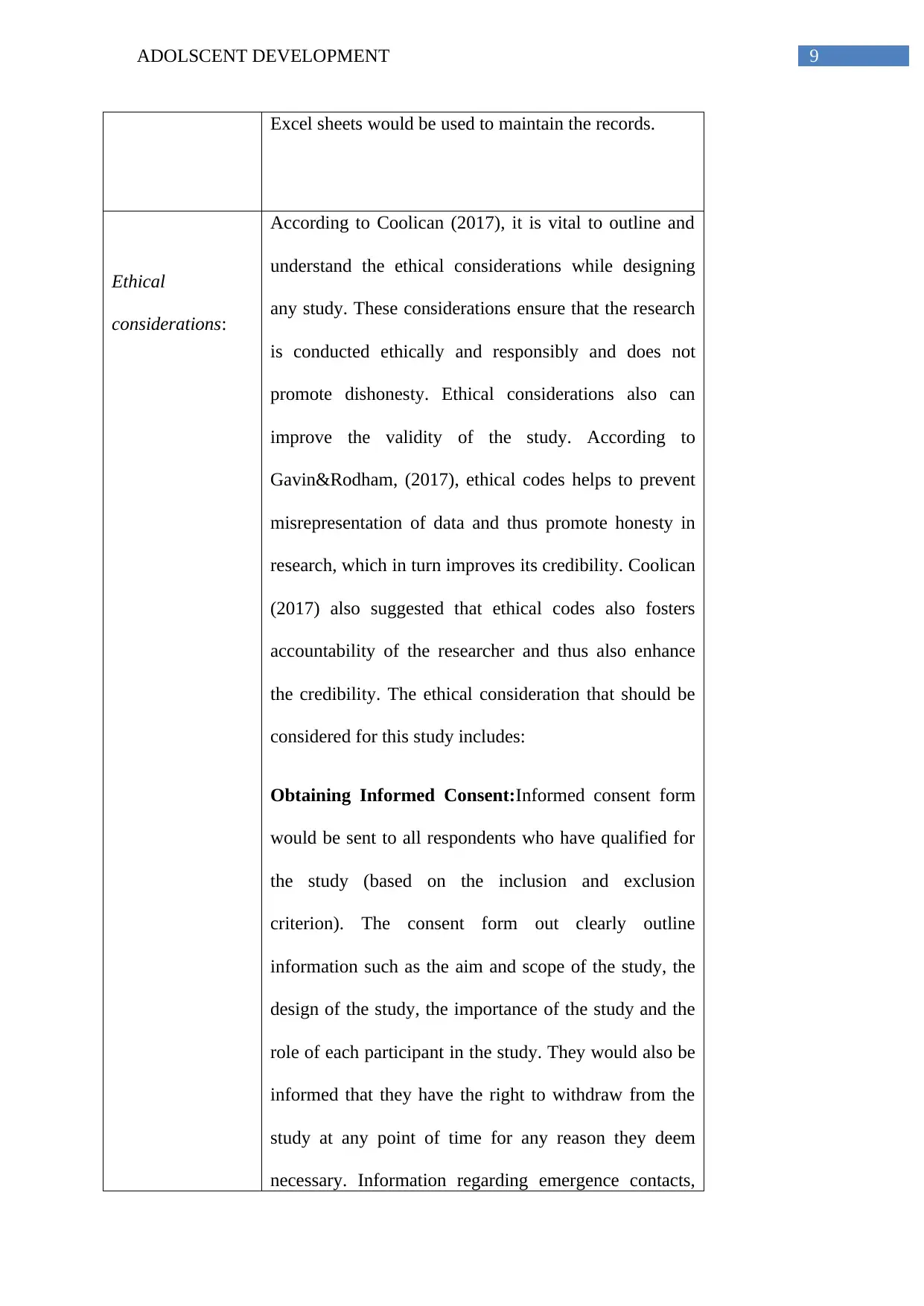
9ADOLSCENT DEVELOPMENT
Excel sheets would be used to maintain the records.
Ethical
considerations:
According to Coolican (2017), it is vital to outline and
understand the ethical considerations while designing
any study. These considerations ensure that the research
is conducted ethically and responsibly and does not
promote dishonesty. Ethical considerations also can
improve the validity of the study. According to
Gavin&Rodham, (2017), ethical codes helps to prevent
misrepresentation of data and thus promote honesty in
research, which in turn improves its credibility. Coolican
(2017) also suggested that ethical codes also fosters
accountability of the researcher and thus also enhance
the credibility. The ethical consideration that should be
considered for this study includes:
Obtaining Informed Consent:Informed consent form
would be sent to all respondents who have qualified for
the study (based on the inclusion and exclusion
criterion). The consent form out clearly outline
information such as the aim and scope of the study, the
design of the study, the importance of the study and the
role of each participant in the study. They would also be
informed that they have the right to withdraw from the
study at any point of time for any reason they deem
necessary. Information regarding emergence contacts,
Excel sheets would be used to maintain the records.
Ethical
considerations:
According to Coolican (2017), it is vital to outline and
understand the ethical considerations while designing
any study. These considerations ensure that the research
is conducted ethically and responsibly and does not
promote dishonesty. Ethical considerations also can
improve the validity of the study. According to
Gavin&Rodham, (2017), ethical codes helps to prevent
misrepresentation of data and thus promote honesty in
research, which in turn improves its credibility. Coolican
(2017) also suggested that ethical codes also fosters
accountability of the researcher and thus also enhance
the credibility. The ethical consideration that should be
considered for this study includes:
Obtaining Informed Consent:Informed consent form
would be sent to all respondents who have qualified for
the study (based on the inclusion and exclusion
criterion). The consent form out clearly outline
information such as the aim and scope of the study, the
design of the study, the importance of the study and the
role of each participant in the study. They would also be
informed that they have the right to withdraw from the
study at any point of time for any reason they deem
necessary. Information regarding emergence contacts,
Secure Best Marks with AI Grader
Need help grading? Try our AI Grader for instant feedback on your assignments.
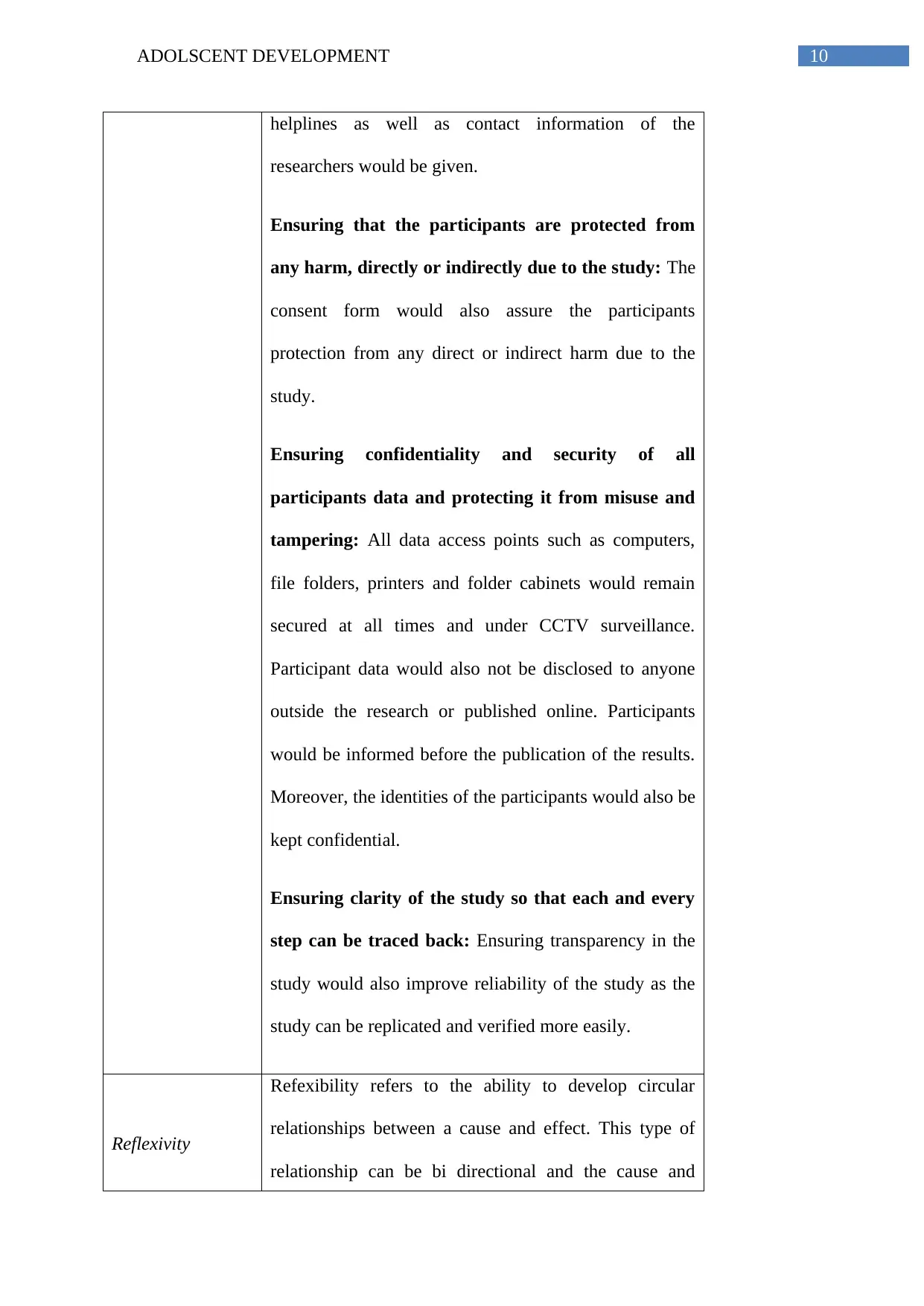
10ADOLSCENT DEVELOPMENT
helplines as well as contact information of the
researchers would be given.
Ensuring that the participants are protected from
any harm, directly or indirectly due to the study: The
consent form would also assure the participants
protection from any direct or indirect harm due to the
study.
Ensuring confidentiality and security of all
participants data and protecting it from misuse and
tampering: All data access points such as computers,
file folders, printers and folder cabinets would remain
secured at all times and under CCTV surveillance.
Participant data would also not be disclosed to anyone
outside the research or published online. Participants
would be informed before the publication of the results.
Moreover, the identities of the participants would also be
kept confidential.
Ensuring clarity of the study so that each and every
step can be traced back: Ensuring transparency in the
study would also improve reliability of the study as the
study can be replicated and verified more easily.
Reflexivity
Refexibility refers to the ability to develop circular
relationships between a cause and effect. This type of
relationship can be bi directional and the cause and
helplines as well as contact information of the
researchers would be given.
Ensuring that the participants are protected from
any harm, directly or indirectly due to the study: The
consent form would also assure the participants
protection from any direct or indirect harm due to the
study.
Ensuring confidentiality and security of all
participants data and protecting it from misuse and
tampering: All data access points such as computers,
file folders, printers and folder cabinets would remain
secured at all times and under CCTV surveillance.
Participant data would also not be disclosed to anyone
outside the research or published online. Participants
would be informed before the publication of the results.
Moreover, the identities of the participants would also be
kept confidential.
Ensuring clarity of the study so that each and every
step can be traced back: Ensuring transparency in the
study would also improve reliability of the study as the
study can be replicated and verified more easily.
Reflexivity
Refexibility refers to the ability to develop circular
relationships between a cause and effect. This type of
relationship can be bi directional and the cause and
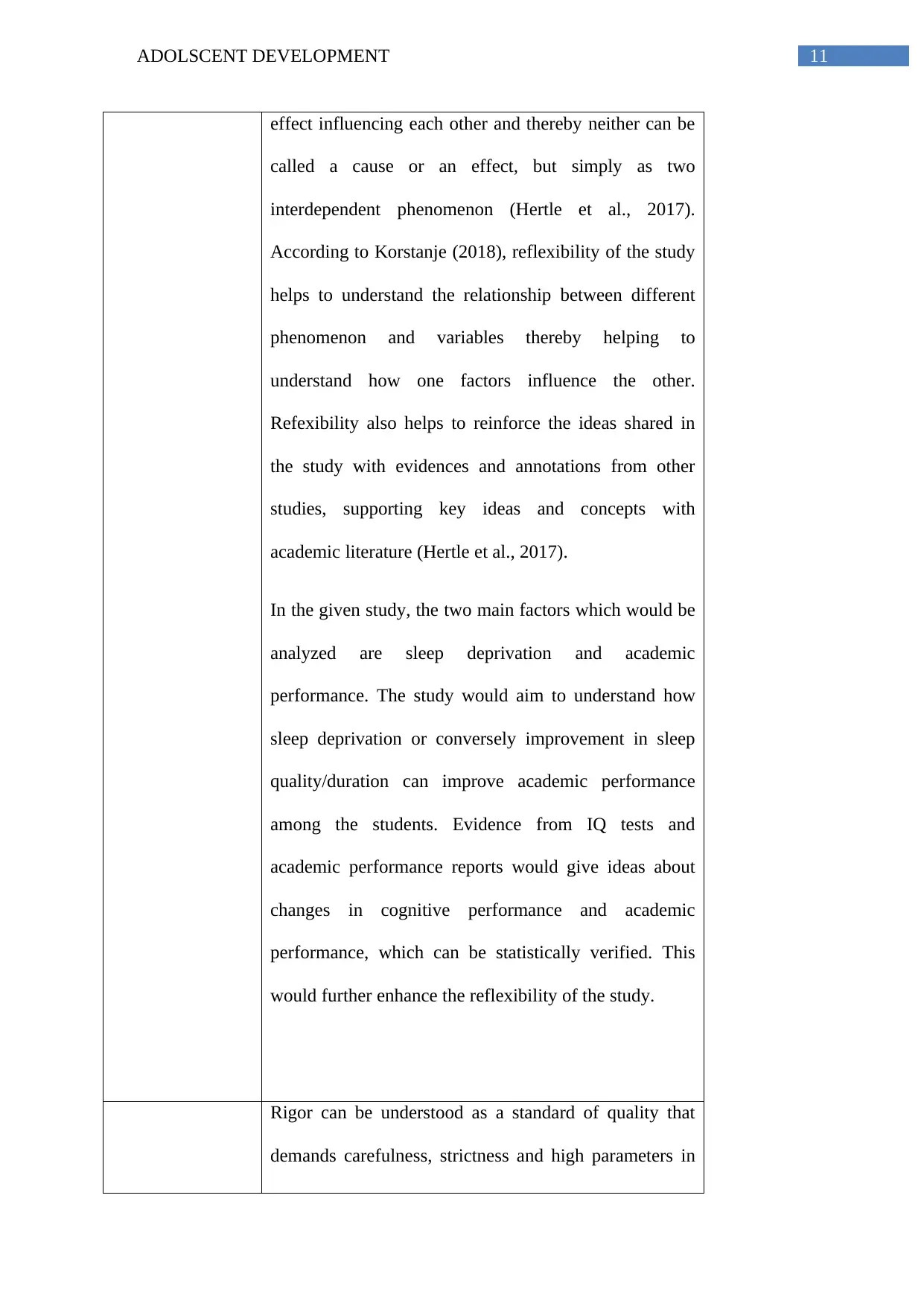
11ADOLSCENT DEVELOPMENT
effect influencing each other and thereby neither can be
called a cause or an effect, but simply as two
interdependent phenomenon (Hertle et al., 2017).
According to Korstanje (2018), reflexibility of the study
helps to understand the relationship between different
phenomenon and variables thereby helping to
understand how one factors influence the other.
Refexibility also helps to reinforce the ideas shared in
the study with evidences and annotations from other
studies, supporting key ideas and concepts with
academic literature (Hertle et al., 2017).
In the given study, the two main factors which would be
analyzed are sleep deprivation and academic
performance. The study would aim to understand how
sleep deprivation or conversely improvement in sleep
quality/duration can improve academic performance
among the students. Evidence from IQ tests and
academic performance reports would give ideas about
changes in cognitive performance and academic
performance, which can be statistically verified. This
would further enhance the reflexibility of the study.
Rigor can be understood as a standard of quality that
demands carefulness, strictness and high parameters in
effect influencing each other and thereby neither can be
called a cause or an effect, but simply as two
interdependent phenomenon (Hertle et al., 2017).
According to Korstanje (2018), reflexibility of the study
helps to understand the relationship between different
phenomenon and variables thereby helping to
understand how one factors influence the other.
Refexibility also helps to reinforce the ideas shared in
the study with evidences and annotations from other
studies, supporting key ideas and concepts with
academic literature (Hertle et al., 2017).
In the given study, the two main factors which would be
analyzed are sleep deprivation and academic
performance. The study would aim to understand how
sleep deprivation or conversely improvement in sleep
quality/duration can improve academic performance
among the students. Evidence from IQ tests and
academic performance reports would give ideas about
changes in cognitive performance and academic
performance, which can be statistically verified. This
would further enhance the reflexibility of the study.
Rigor can be understood as a standard of quality that
demands carefulness, strictness and high parameters in
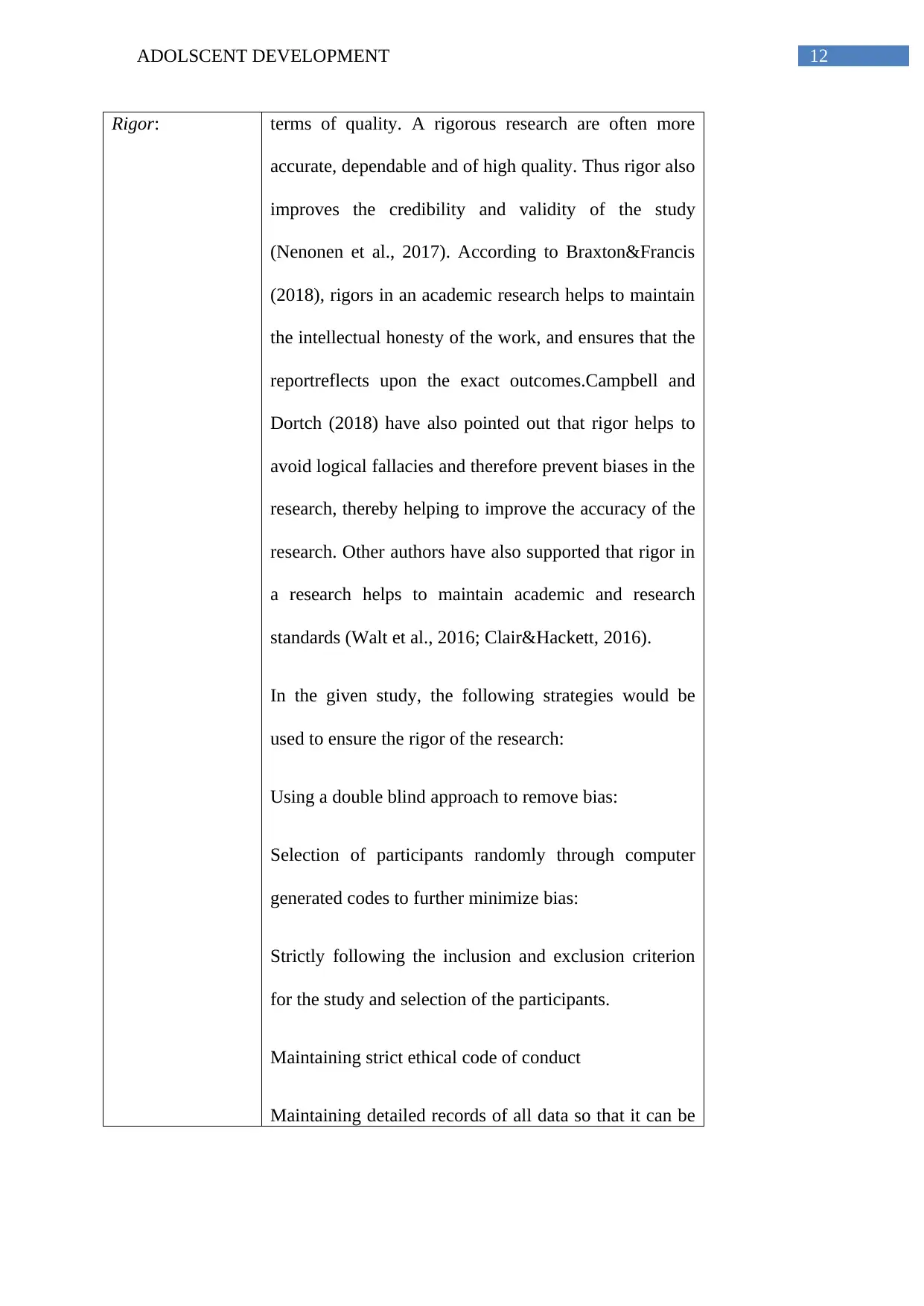
12ADOLSCENT DEVELOPMENT
Rigor: terms of quality. A rigorous research are often more
accurate, dependable and of high quality. Thus rigor also
improves the credibility and validity of the study
(Nenonen et al., 2017). According to Braxton&Francis
(2018), rigors in an academic research helps to maintain
the intellectual honesty of the work, and ensures that the
reportreflects upon the exact outcomes.Campbell and
Dortch (2018) have also pointed out that rigor helps to
avoid logical fallacies and therefore prevent biases in the
research, thereby helping to improve the accuracy of the
research. Other authors have also supported that rigor in
a research helps to maintain academic and research
standards (Walt et al., 2016; Clair&Hackett, 2016).
In the given study, the following strategies would be
used to ensure the rigor of the research:
Using a double blind approach to remove bias:
Selection of participants randomly through computer
generated codes to further minimize bias:
Strictly following the inclusion and exclusion criterion
for the study and selection of the participants.
Maintaining strict ethical code of conduct
Maintaining detailed records of all data so that it can be
Rigor: terms of quality. A rigorous research are often more
accurate, dependable and of high quality. Thus rigor also
improves the credibility and validity of the study
(Nenonen et al., 2017). According to Braxton&Francis
(2018), rigors in an academic research helps to maintain
the intellectual honesty of the work, and ensures that the
reportreflects upon the exact outcomes.Campbell and
Dortch (2018) have also pointed out that rigor helps to
avoid logical fallacies and therefore prevent biases in the
research, thereby helping to improve the accuracy of the
research. Other authors have also supported that rigor in
a research helps to maintain academic and research
standards (Walt et al., 2016; Clair&Hackett, 2016).
In the given study, the following strategies would be
used to ensure the rigor of the research:
Using a double blind approach to remove bias:
Selection of participants randomly through computer
generated codes to further minimize bias:
Strictly following the inclusion and exclusion criterion
for the study and selection of the participants.
Maintaining strict ethical code of conduct
Maintaining detailed records of all data so that it can be
Paraphrase This Document
Need a fresh take? Get an instant paraphrase of this document with our AI Paraphraser
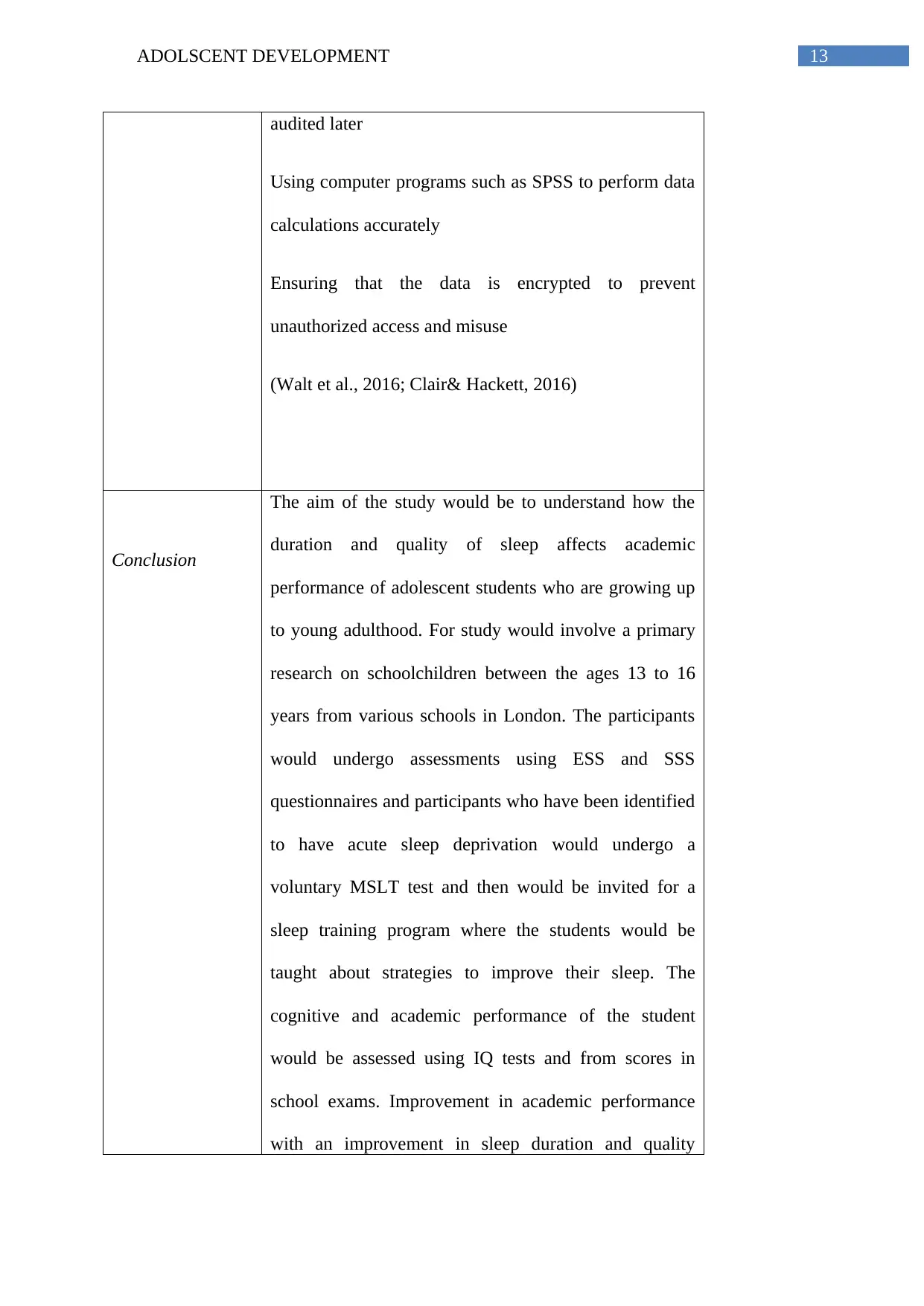
13ADOLSCENT DEVELOPMENT
audited later
Using computer programs such as SPSS to perform data
calculations accurately
Ensuring that the data is encrypted to prevent
unauthorized access and misuse
(Walt et al., 2016; Clair& Hackett, 2016)
Conclusion
The aim of the study would be to understand how the
duration and quality of sleep affects academic
performance of adolescent students who are growing up
to young adulthood. For study would involve a primary
research on schoolchildren between the ages 13 to 16
years from various schools in London. The participants
would undergo assessments using ESS and SSS
questionnaires and participants who have been identified
to have acute sleep deprivation would undergo a
voluntary MSLT test and then would be invited for a
sleep training program where the students would be
taught about strategies to improve their sleep. The
cognitive and academic performance of the student
would be assessed using IQ tests and from scores in
school exams. Improvement in academic performance
with an improvement in sleep duration and quality
audited later
Using computer programs such as SPSS to perform data
calculations accurately
Ensuring that the data is encrypted to prevent
unauthorized access and misuse
(Walt et al., 2016; Clair& Hackett, 2016)
Conclusion
The aim of the study would be to understand how the
duration and quality of sleep affects academic
performance of adolescent students who are growing up
to young adulthood. For study would involve a primary
research on schoolchildren between the ages 13 to 16
years from various schools in London. The participants
would undergo assessments using ESS and SSS
questionnaires and participants who have been identified
to have acute sleep deprivation would undergo a
voluntary MSLT test and then would be invited for a
sleep training program where the students would be
taught about strategies to improve their sleep. The
cognitive and academic performance of the student
would be assessed using IQ tests and from scores in
school exams. Improvement in academic performance
with an improvement in sleep duration and quality
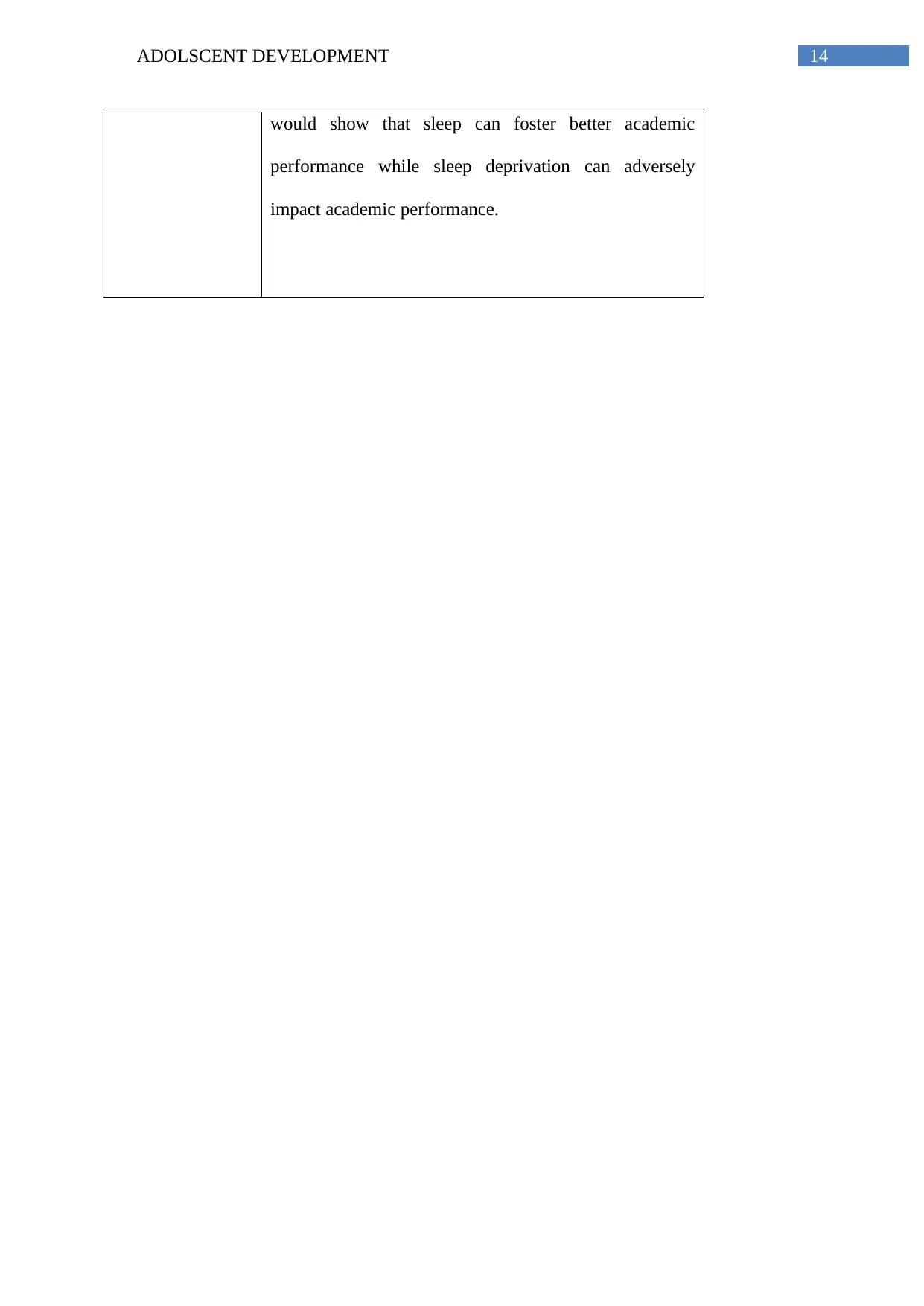
14ADOLSCENT DEVELOPMENT
would show that sleep can foster better academic
performance while sleep deprivation can adversely
impact academic performance.
would show that sleep can foster better academic
performance while sleep deprivation can adversely
impact academic performance.
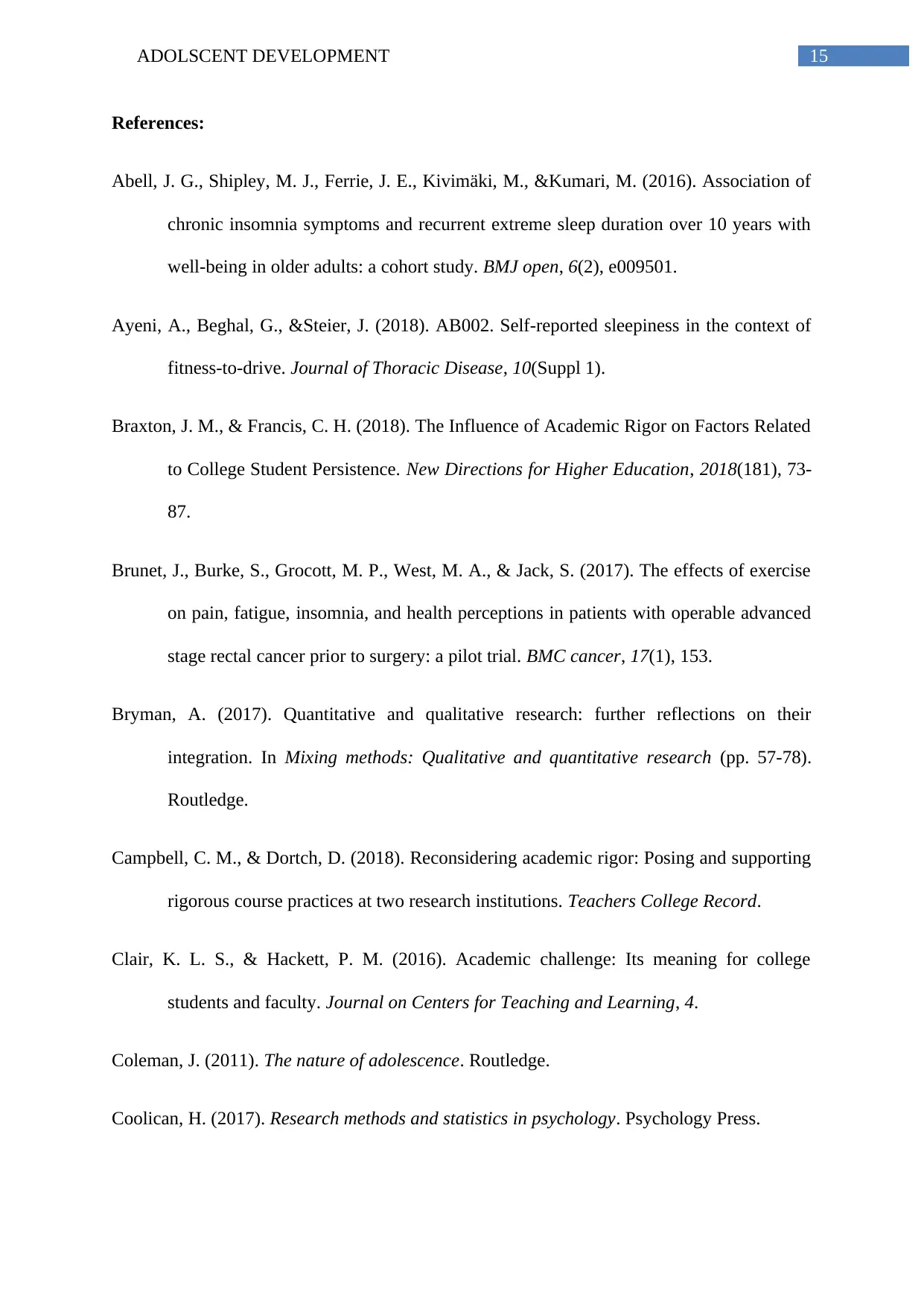
15ADOLSCENT DEVELOPMENT
References:
Abell, J. G., Shipley, M. J., Ferrie, J. E., Kivimäki, M., &Kumari, M. (2016). Association of
chronic insomnia symptoms and recurrent extreme sleep duration over 10 years with
well-being in older adults: a cohort study. BMJ open, 6(2), e009501.
Ayeni, A., Beghal, G., &Steier, J. (2018). AB002. Self-reported sleepiness in the context of
fitness-to-drive. Journal of Thoracic Disease, 10(Suppl 1).
Braxton, J. M., & Francis, C. H. (2018). The Influence of Academic Rigor on Factors Related
to College Student Persistence. New Directions for Higher Education, 2018(181), 73-
87.
Brunet, J., Burke, S., Grocott, M. P., West, M. A., & Jack, S. (2017). The effects of exercise
on pain, fatigue, insomnia, and health perceptions in patients with operable advanced
stage rectal cancer prior to surgery: a pilot trial. BMC cancer, 17(1), 153.
Bryman, A. (2017). Quantitative and qualitative research: further reflections on their
integration. In Mixing methods: Qualitative and quantitative research (pp. 57-78).
Routledge.
Campbell, C. M., & Dortch, D. (2018). Reconsidering academic rigor: Posing and supporting
rigorous course practices at two research institutions. Teachers College Record.
Clair, K. L. S., & Hackett, P. M. (2016). Academic challenge: Its meaning for college
students and faculty. Journal on Centers for Teaching and Learning, 4.
Coleman, J. (2011). The nature of adolescence. Routledge.
Coolican, H. (2017). Research methods and statistics in psychology. Psychology Press.
References:
Abell, J. G., Shipley, M. J., Ferrie, J. E., Kivimäki, M., &Kumari, M. (2016). Association of
chronic insomnia symptoms and recurrent extreme sleep duration over 10 years with
well-being in older adults: a cohort study. BMJ open, 6(2), e009501.
Ayeni, A., Beghal, G., &Steier, J. (2018). AB002. Self-reported sleepiness in the context of
fitness-to-drive. Journal of Thoracic Disease, 10(Suppl 1).
Braxton, J. M., & Francis, C. H. (2018). The Influence of Academic Rigor on Factors Related
to College Student Persistence. New Directions for Higher Education, 2018(181), 73-
87.
Brunet, J., Burke, S., Grocott, M. P., West, M. A., & Jack, S. (2017). The effects of exercise
on pain, fatigue, insomnia, and health perceptions in patients with operable advanced
stage rectal cancer prior to surgery: a pilot trial. BMC cancer, 17(1), 153.
Bryman, A. (2017). Quantitative and qualitative research: further reflections on their
integration. In Mixing methods: Qualitative and quantitative research (pp. 57-78).
Routledge.
Campbell, C. M., & Dortch, D. (2018). Reconsidering academic rigor: Posing and supporting
rigorous course practices at two research institutions. Teachers College Record.
Clair, K. L. S., & Hackett, P. M. (2016). Academic challenge: Its meaning for college
students and faculty. Journal on Centers for Teaching and Learning, 4.
Coleman, J. (2011). The nature of adolescence. Routledge.
Coolican, H. (2017). Research methods and statistics in psychology. Psychology Press.
Secure Best Marks with AI Grader
Need help grading? Try our AI Grader for instant feedback on your assignments.
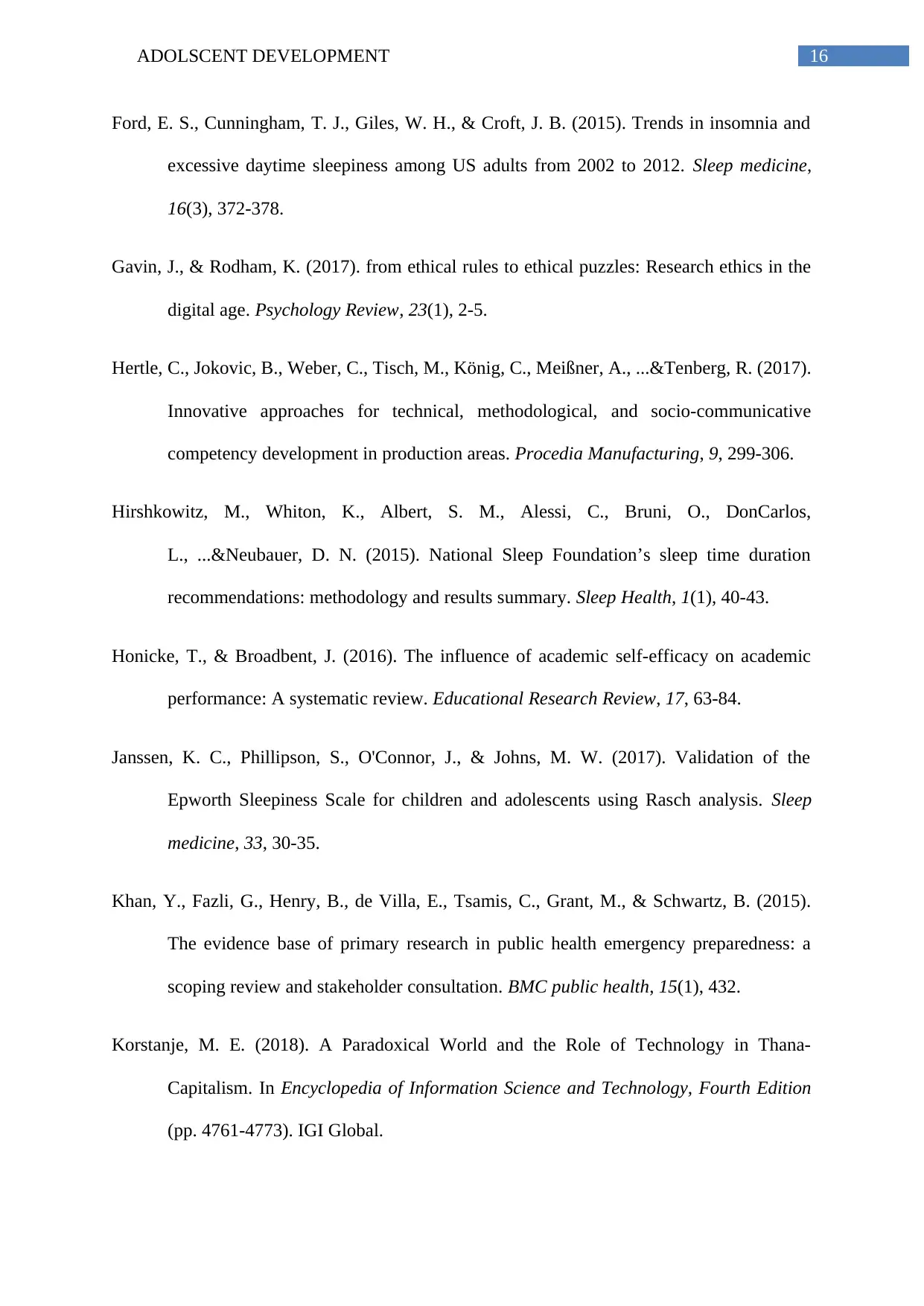
16ADOLSCENT DEVELOPMENT
Ford, E. S., Cunningham, T. J., Giles, W. H., & Croft, J. B. (2015). Trends in insomnia and
excessive daytime sleepiness among US adults from 2002 to 2012. Sleep medicine,
16(3), 372-378.
Gavin, J., & Rodham, K. (2017). from ethical rules to ethical puzzles: Research ethics in the
digital age. Psychology Review, 23(1), 2-5.
Hertle, C., Jokovic, B., Weber, C., Tisch, M., König, C., Meißner, A., ...&Tenberg, R. (2017).
Innovative approaches for technical, methodological, and socio-communicative
competency development in production areas. Procedia Manufacturing, 9, 299-306.
Hirshkowitz, M., Whiton, K., Albert, S. M., Alessi, C., Bruni, O., DonCarlos,
L., ...&Neubauer, D. N. (2015). National Sleep Foundation’s sleep time duration
recommendations: methodology and results summary. Sleep Health, 1(1), 40-43.
Honicke, T., & Broadbent, J. (2016). The influence of academic self-efficacy on academic
performance: A systematic review. Educational Research Review, 17, 63-84.
Janssen, K. C., Phillipson, S., O'Connor, J., & Johns, M. W. (2017). Validation of the
Epworth Sleepiness Scale for children and adolescents using Rasch analysis. Sleep
medicine, 33, 30-35.
Khan, Y., Fazli, G., Henry, B., de Villa, E., Tsamis, C., Grant, M., & Schwartz, B. (2015).
The evidence base of primary research in public health emergency preparedness: a
scoping review and stakeholder consultation. BMC public health, 15(1), 432.
Korstanje, M. E. (2018). A Paradoxical World and the Role of Technology in Thana-
Capitalism. In Encyclopedia of Information Science and Technology, Fourth Edition
(pp. 4761-4773). IGI Global.
Ford, E. S., Cunningham, T. J., Giles, W. H., & Croft, J. B. (2015). Trends in insomnia and
excessive daytime sleepiness among US adults from 2002 to 2012. Sleep medicine,
16(3), 372-378.
Gavin, J., & Rodham, K. (2017). from ethical rules to ethical puzzles: Research ethics in the
digital age. Psychology Review, 23(1), 2-5.
Hertle, C., Jokovic, B., Weber, C., Tisch, M., König, C., Meißner, A., ...&Tenberg, R. (2017).
Innovative approaches for technical, methodological, and socio-communicative
competency development in production areas. Procedia Manufacturing, 9, 299-306.
Hirshkowitz, M., Whiton, K., Albert, S. M., Alessi, C., Bruni, O., DonCarlos,
L., ...&Neubauer, D. N. (2015). National Sleep Foundation’s sleep time duration
recommendations: methodology and results summary. Sleep Health, 1(1), 40-43.
Honicke, T., & Broadbent, J. (2016). The influence of academic self-efficacy on academic
performance: A systematic review. Educational Research Review, 17, 63-84.
Janssen, K. C., Phillipson, S., O'Connor, J., & Johns, M. W. (2017). Validation of the
Epworth Sleepiness Scale for children and adolescents using Rasch analysis. Sleep
medicine, 33, 30-35.
Khan, Y., Fazli, G., Henry, B., de Villa, E., Tsamis, C., Grant, M., & Schwartz, B. (2015).
The evidence base of primary research in public health emergency preparedness: a
scoping review and stakeholder consultation. BMC public health, 15(1), 432.
Korstanje, M. E. (2018). A Paradoxical World and the Role of Technology in Thana-
Capitalism. In Encyclopedia of Information Science and Technology, Fourth Edition
(pp. 4761-4773). IGI Global.
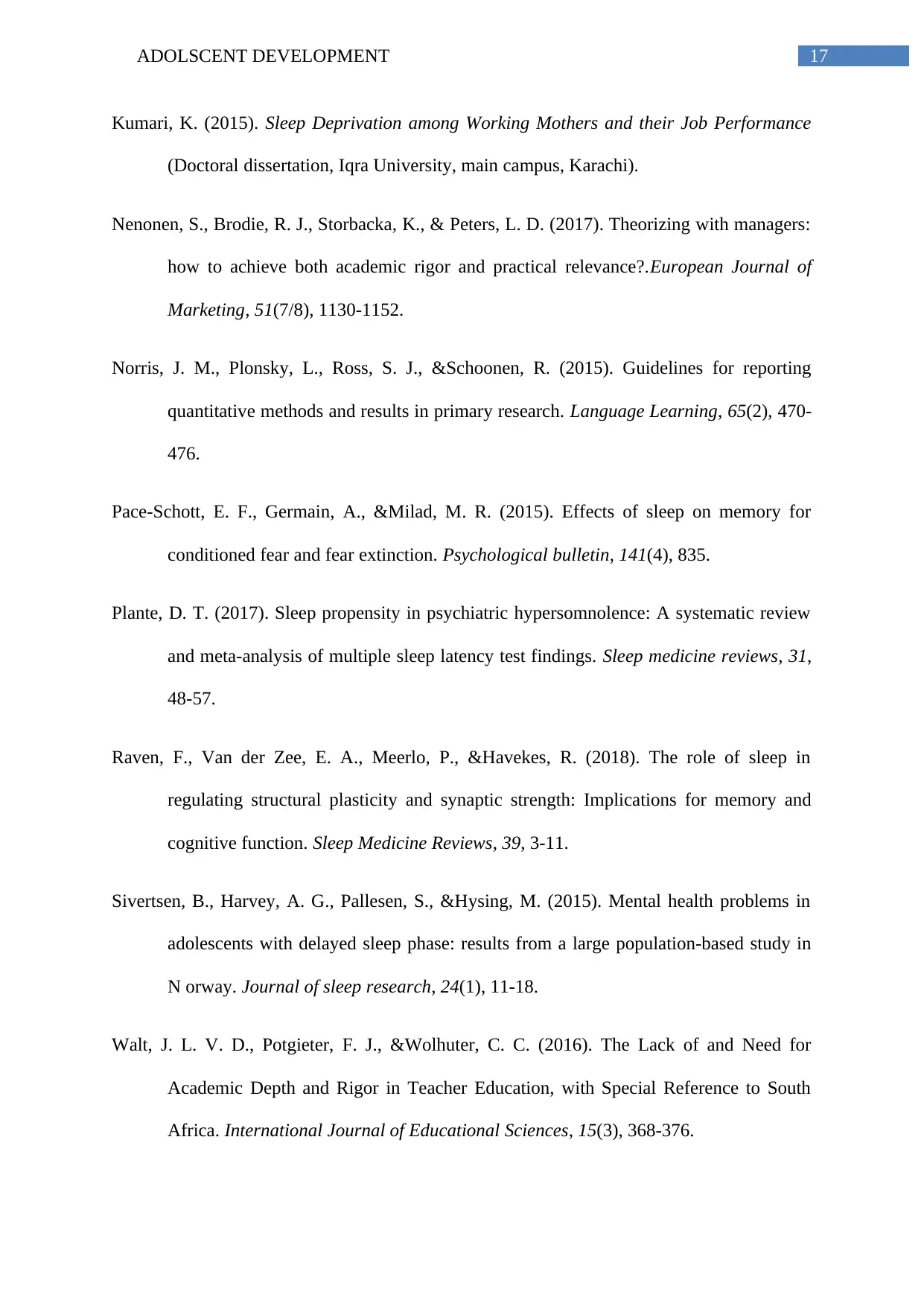
17ADOLSCENT DEVELOPMENT
Kumari, K. (2015). Sleep Deprivation among Working Mothers and their Job Performance
(Doctoral dissertation, Iqra University, main campus, Karachi).
Nenonen, S., Brodie, R. J., Storbacka, K., & Peters, L. D. (2017). Theorizing with managers:
how to achieve both academic rigor and practical relevance?.European Journal of
Marketing, 51(7/8), 1130-1152.
Norris, J. M., Plonsky, L., Ross, S. J., &Schoonen, R. (2015). Guidelines for reporting
quantitative methods and results in primary research. Language Learning, 65(2), 470-
476.
Pace-Schott, E. F., Germain, A., &Milad, M. R. (2015). Effects of sleep on memory for
conditioned fear and fear extinction. Psychological bulletin, 141(4), 835.
Plante, D. T. (2017). Sleep propensity in psychiatric hypersomnolence: A systematic review
and meta-analysis of multiple sleep latency test findings. Sleep medicine reviews, 31,
48-57.
Raven, F., Van der Zee, E. A., Meerlo, P., &Havekes, R. (2018). The role of sleep in
regulating structural plasticity and synaptic strength: Implications for memory and
cognitive function. Sleep Medicine Reviews, 39, 3-11.
Sivertsen, B., Harvey, A. G., Pallesen, S., &Hysing, M. (2015). Mental health problems in
adolescents with delayed sleep phase: results from a large population‐based study in
N orway. Journal of sleep research, 24(1), 11-18.
Walt, J. L. V. D., Potgieter, F. J., &Wolhuter, C. C. (2016). The Lack of and Need for
Academic Depth and Rigor in Teacher Education, with Special Reference to South
Africa. International Journal of Educational Sciences, 15(3), 368-376.
Kumari, K. (2015). Sleep Deprivation among Working Mothers and their Job Performance
(Doctoral dissertation, Iqra University, main campus, Karachi).
Nenonen, S., Brodie, R. J., Storbacka, K., & Peters, L. D. (2017). Theorizing with managers:
how to achieve both academic rigor and practical relevance?.European Journal of
Marketing, 51(7/8), 1130-1152.
Norris, J. M., Plonsky, L., Ross, S. J., &Schoonen, R. (2015). Guidelines for reporting
quantitative methods and results in primary research. Language Learning, 65(2), 470-
476.
Pace-Schott, E. F., Germain, A., &Milad, M. R. (2015). Effects of sleep on memory for
conditioned fear and fear extinction. Psychological bulletin, 141(4), 835.
Plante, D. T. (2017). Sleep propensity in psychiatric hypersomnolence: A systematic review
and meta-analysis of multiple sleep latency test findings. Sleep medicine reviews, 31,
48-57.
Raven, F., Van der Zee, E. A., Meerlo, P., &Havekes, R. (2018). The role of sleep in
regulating structural plasticity and synaptic strength: Implications for memory and
cognitive function. Sleep Medicine Reviews, 39, 3-11.
Sivertsen, B., Harvey, A. G., Pallesen, S., &Hysing, M. (2015). Mental health problems in
adolescents with delayed sleep phase: results from a large population‐based study in
N orway. Journal of sleep research, 24(1), 11-18.
Walt, J. L. V. D., Potgieter, F. J., &Wolhuter, C. C. (2016). The Lack of and Need for
Academic Depth and Rigor in Teacher Education, with Special Reference to South
Africa. International Journal of Educational Sciences, 15(3), 368-376.
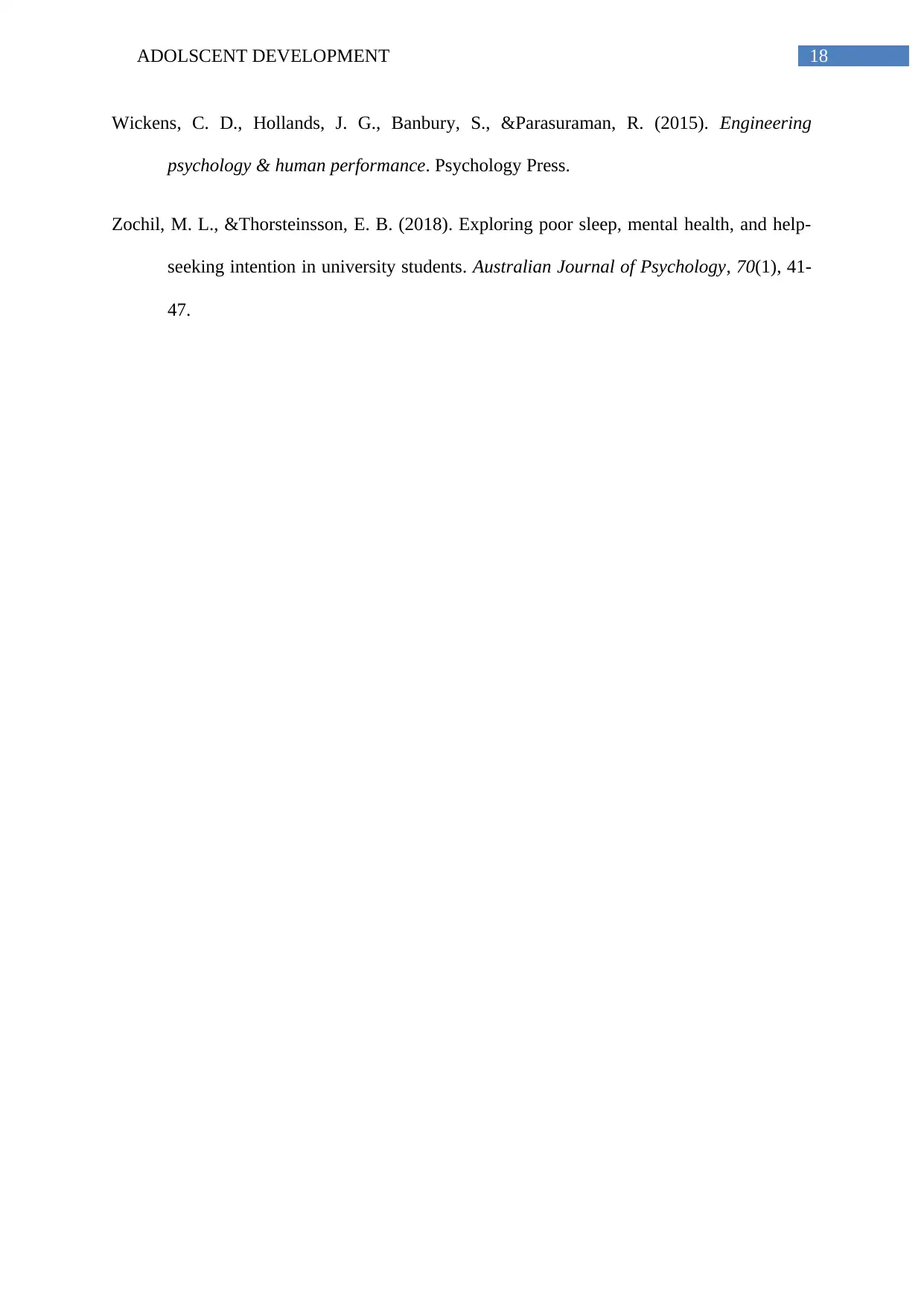
18ADOLSCENT DEVELOPMENT
Wickens, C. D., Hollands, J. G., Banbury, S., &Parasuraman, R. (2015). Engineering
psychology & human performance. Psychology Press.
Zochil, M. L., &Thorsteinsson, E. B. (2018). Exploring poor sleep, mental health, and help‐
seeking intention in university students. Australian Journal of Psychology, 70(1), 41-
47.
Wickens, C. D., Hollands, J. G., Banbury, S., &Parasuraman, R. (2015). Engineering
psychology & human performance. Psychology Press.
Zochil, M. L., &Thorsteinsson, E. B. (2018). Exploring poor sleep, mental health, and help‐
seeking intention in university students. Australian Journal of Psychology, 70(1), 41-
47.
1 out of 19
Related Documents
Your All-in-One AI-Powered Toolkit for Academic Success.
+13062052269
info@desklib.com
Available 24*7 on WhatsApp / Email
![[object Object]](/_next/static/media/star-bottom.7253800d.svg)
Unlock your academic potential
© 2024 | Zucol Services PVT LTD | All rights reserved.



